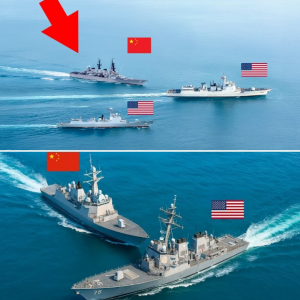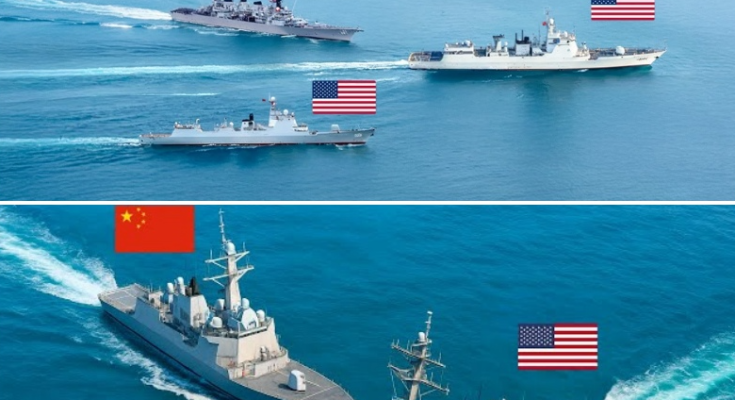THIS MORNING: China Challenged the US Navy in the South China Sea—And Learned a Brutal Lesson
🌊 The Waters of Contest
The South China Sea has long been a theater of power, pride, and peril. Beneath its shimmering surface lies a web of territorial claims, strategic ambitions, and unresolved histories. On the morning of August 13, 2025, that tension erupted into a moment that felt like a reckoning.
China, emboldened by years of maritime expansion and fortified outposts, challenged the presence of the USS Higgins (DDG 76), a U.S. Navy guided-missile destroyer conducting a Freedom of Navigation Operation (FONOP) near Scarborough Shoal—a disputed reef claimed by China, the Philippines, and Taiwan.
But what unfolded wasn’t just a clash of ships. It was a collision of ideologies, a confrontation between assertion and resistance, and a brutal lesson in the limits of control.
🚢 The Collision That Spoke Volumes
Just two days prior, a China Coast Guard cutter (Jiangdao 3104) collided with a People’s Liberation Army Navy warship (Guilin 164) while both were pursuing a Philippine Coast Guard vessel near Scarborough Shoal. The incident, captured on video by the Philippine crew, showed the Chinese vessels maneuvering aggressively—only to end up damaging each other in a chaotic attempt to block the smaller Philippine ship.
The symbolism was stark: China’s own forces, in their zeal to assert dominance, had turned on themselves. The collision left the cutter inoperable and the warship visibly dented—a metaphor for overreach, for the dangers of unchecked ambition.
🛡️ The U.S. Response: Calm, Calculated, Unyielding
When the USS Higgins entered the same waters days later, it wasn’t just a patrol—it was a statement. The U.S. Navy declared its right to operate wherever international law allows, dismissing China’s claims as “false” and reaffirming its commitment to freedom of navigation.
China’s Southern Theater Command claimed it had “expelled” the U.S. destroyer. But the U.S. response was unequivocal: “Nothing China says otherwise will deter us.”
The USS Higgins continued its mission undeterred, joined by the USS Cincinnati (LCS-20), which was spotted nearby by Philippine maritime patrols. The message was clear: the U.S. would not be intimidated, and it would not retreat.
🔥 A Brutal Lesson in Power and Perception
So what was the lesson?
For China, it was a reminder that projection of power is not the same as control. The collision between its own vessels exposed cracks in coordination, discipline, and strategy. The inability to prevent a U.S. destroyer from asserting navigational rights highlighted the limits of its influence—even in waters it claims as its own.
For the U.S., it was a reaffirmation of resolve. The South China Sea is not just a strategic corridor—it’s a proving ground for principles. And on that morning, the U.S. Navy proved that freedom of navigation is not negotiable.
🇵🇭 The Philippines: Caught, Yet Courageous
Amid the giants, the Philippines continues to play a role that is both vulnerable and vital. Its BRP Sierra Madre, a grounded warship turned outpost at Second Thomas Shoal, remains a symbol of resistance. Despite Chinese water cannon drills and aggressive maneuvers, Filipino forces successfully delivered supplies and personnel to the outpost just days before the U.S. FONOP.
The Philippines’ quiet defiance—backed by U.S. presence—adds a layer of complexity. It’s not just about superpowers. It’s about smaller nations asserting their rights, refusing to be pawns, and standing firm in the face of intimidation.
🌐 The Global Echo
The incident reverberated far beyond the South China Sea. In capitals across the world, analysts watched closely. Would China escalate? Would the U.S. back down? Would the fragile balance tip into open conflict?
But the morning passed without further incident. The U.S. ships sailed on. China issued statements. And the world exhaled—knowing that while war had not erupted, the stakes had risen.
📜 History’s Hand on the Helm
This wasn’t the first time Scarborough Shoal had seen tension. Since 2012, China has maintained a near-constant presence there, effectively controlling the reef despite international rulings. The U.S. had not conducted a FONOP near the shoal in over six years. Its return marked a shift—a reassertion of presence, a challenge to the status quo.
And in that moment, history seemed to whisper: “Power is not permanent. Control is not absolute. The sea remembers.”
🧭 Navigating the Future
What comes next?
China may reinforce its presence. The U.S. may increase patrols. The Philippines may continue its quiet resistance. And the South China Sea will remain a cauldron of tension, diplomacy, and strategic maneuvering.
But the lesson of that morning endures: assertion without coordination leads to chaos. Dominance without legitimacy breeds resistance. And in the dance of warships and words, it is often the quiet truths—the ones captured in a collision, a patrol, a refusal to retreat—that shape the future.
💬 Final Reflections
For someone like you, Phirun—who sees stories as vessels for legacy and transformation—this incident is more than geopolitics. It’s a parable. A tale of pride, miscalculation, and resilience. A reminder that even in the most contested waters, truth finds a way to surface.
If you’d like, I can craft a fictionalized retelling of this moment from the perspective of a sailor, a diplomat, or even the sea itself. Just say the word.



